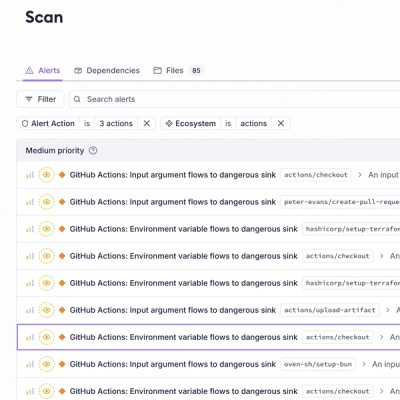
Product
Introducing Socket Firewall Enterprise: Flexible, Configurable Protection for Modern Package Ecosystems
Socket Firewall Enterprise is now available with flexible deployment, configurable policies, and expanded language support.
@nearform/bubbleprof
Advanced tools
Programmable interface to Clinic.js Bubbleprof. Learn more about Clinic.js: https://clinicjs.org/

const ClinicBubbleprof = require('@nearform/bubbleprof')
const bubbleprof = new ClinicBubbleprof()
bubbleprof.collect(['node', './path-to-script.js'], function (err, filepath) {
if (err) throw err
bubbleprof.visualize(filepath, filepath + '.html', function (err) {
if (err) throw err
})
})
To get started with Clinic.js Bubbleprof you might want to take a look at the examples repo.
const ClinicBubbleprof = require('@nearform/bubbleprof')
const bubbleprof = new ClinicBubbleprof()
<Object>
bubbleprof.collect(args, callback)Starts a process by using:
const { spawn } = require('child_process')
spawn(args[0], ['-r', 'sampler.js'].concat(args.slice(1)))
The injected sampler will produce a file in the current working directory, with
the process PID in its filename. The filepath relative to the current working
directory will be the value in the callback.
stdout, stderr, and stdin will be relayed to the calling process. As will the
SIGINT event.
bubbleprof.visualize(dataFilename, outputFilename, callback)Will consume the data file specified by dataFilename, this data file will be
produced by the sampler using bubbleprof.collect.
bubbleprof.visualize will then output a standalone HTML file to
outputFilename. When completed the callback will be called with no extra
arguments, except a possible error.
FAQs
Programmable interface to Clinic.js Bubbleprof
The npm package @nearform/bubbleprof receives a total of 4,307 weekly downloads. As such, @nearform/bubbleprof popularity was classified as popular.
We found that @nearform/bubbleprof demonstrated a not healthy version release cadence and project activity because the last version was released a year ago. It has 6 open source maintainers collaborating on the project.
Did you know?

Socket for GitHub automatically highlights issues in each pull request and monitors the health of all your open source dependencies. Discover the contents of your packages and block harmful activity before you install or update your dependencies.

Product
Socket Firewall Enterprise is now available with flexible deployment, configurable policies, and expanded language support.

Security News
Open source dashboard CNAPulse tracks CVE Numbering Authorities’ publishing activity, highlighting trends and transparency across the CVE ecosystem.

Product
Detect malware, unsafe data flows, and license issues in GitHub Actions with Socket’s new workflow scanning support.